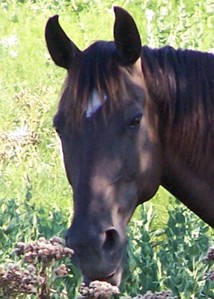Reflections on Equestrian Art

The apex of perfection in equestrian art is not an exhibition of a great deal of different airs and movements by the same horse, but rather the conservation of the horse's enjoyment, suppleness and finesse during the performance, which calls for comparison with the finest ballet, or performance of an orchestra, or seeing a play by Racine, so moving is the sight of perfectly unisoned movements.
In the above quotation, Nuno Oliveira points out the difference between simply making a horse go through the motions of an act and doing so as a willing partner with the rider. He states elsewhere in this volume: “To practise equestrian art is to establish a conversation on a higher level with the horse; a dialogue of courtesy and finesse. The rider obtains the collaboration of the horse by the slightest hint of a demand, and the spectator can then see the sublime beauty of this communion.”
While few riders will be able to obtain the mastery of Nuno Oliveira, every rider can improve by seeking to employ the principles promoted in this book. Even after this man was recognized as a “maestro”, he admitted, “I know that I still have much to learn, and will go on learning until my dying day, not only by riding, but by studying, thinking deeply, and observing.”
The process of learning to ride well includes use of both intellect and experience. On reading, Oliveira writes: “All books are of use to the very advanced rider who has had great practice in riding, so that he can pick out the good advice, using it profitably, while knowing which parts to discard.” He adds, “Above all, it is necessary to ride often, while not entirely allowing the books to gather dust on the shelves.”
On methodology, Oliveira points out: “It is only by rational and calm methods which are never brutal that the horse may become obedient and well balanced.”
Several times, he quotes Captain Beudant's mantra: “Ask for much, be content with little, and reward often.” Oliveira expands on this when he states: “Reward the horse each time he does what is asked of him. Never ask for more than he is capable of giving. Make him a companion, and not a slave, then you will see what a true friend he is.”
Oliveira cautions against following the tactics of those who would rush a horse's training: “We must not be deceived by the apparently rapid results obtained by the use of violence.” He expands on this thought when he says, “The horse will remember when he has been punished in order to force him to carry out an exercise that is uncomfortable for him, and each time that he is asked for that same movement he will become tense, and sometimes rebel in the expectation of punishment.”
Oliveira rightly puts much responsibility on the rider. “So many times riders attribute bad character to horses having a habit of rebellion, when often it is caused by starting certain work without sufficient preparation.” He adds, “A rider who becomes irritable, losing control of his faculties, can do nothing well.”
On the other hand, he states, “A horse will never tire of a rider who possesses both tact and sensitivity because he will never be pushed beyond his possibilities.”
A rider must work on developing himself at least as much as his horse. Oliveira points to the fact that “It is only with a good position and a supple horse that a rider may succeed in stabilising his hands, thus being certain of never pulling on the horse's mouth.”
The rider must be relaxed. “Only the rider who is free from any contraction will have a horse equally free from contraction.”
Oliveira's ideas are not meant only for those who seek to do the passage, the piaffer, the canter pirouette, or the canter to the rear. He clearly points out: “The idea of ensuring sufficient preparation before any new demand is made on the horse can be applied to the jumper, to the dressage horse, and in fact to all horses destined to be trained for whatever purpose.”